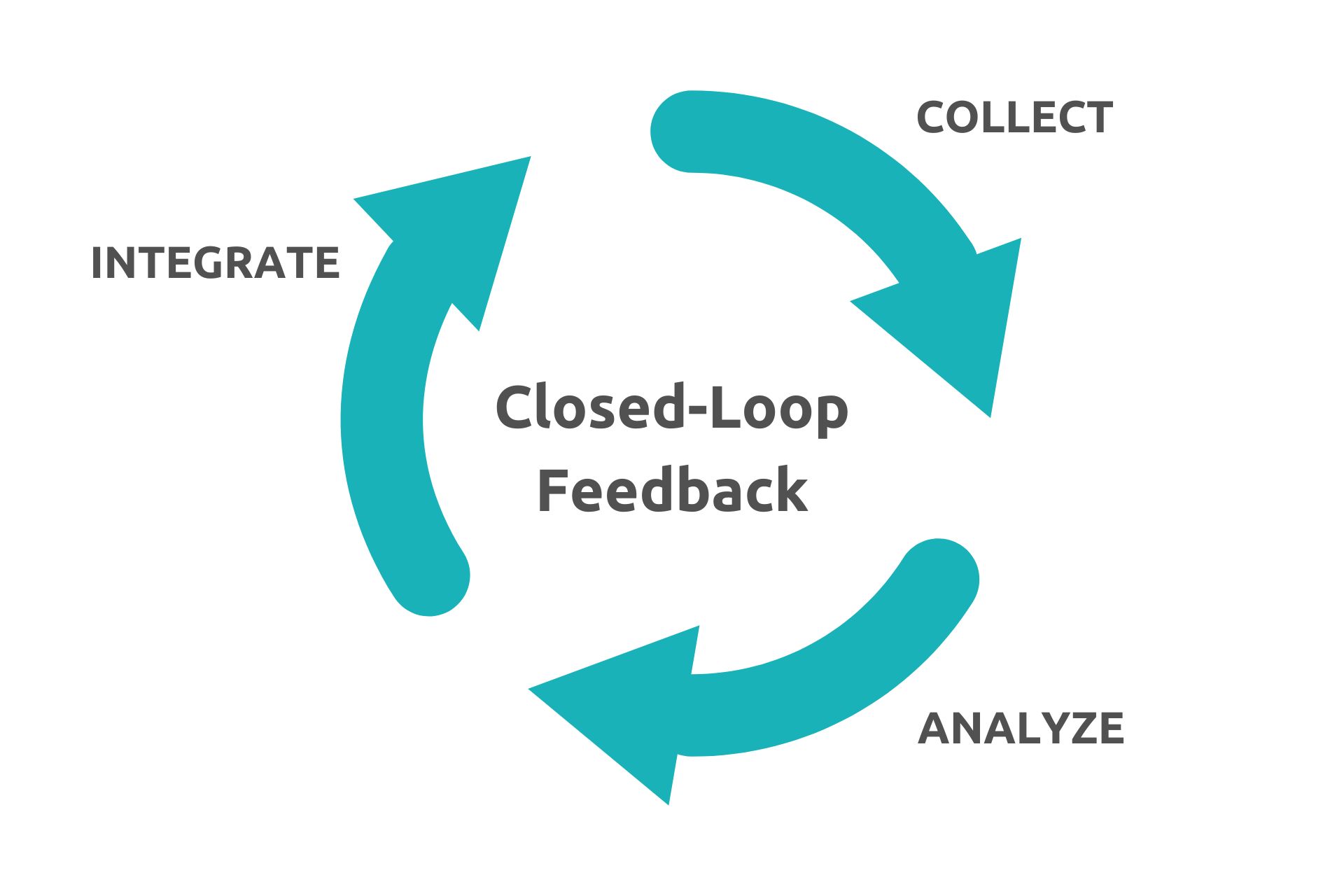
Ensuring customer feedback is properly incorporated into the development process is essential to any app's success. How to do that, however, is not straightforward. You need a system in place that not only collects data, analyzes customer behavior, and logs feedback, but the system also needs to ensure these pieces of information properly inform the company's strategy.
How do you close the loop and ensure customer feedback is accounted for? How do you turn it into a system? What are the steps involved? In this blog post, we'll go over everything related to closed-loop feedback systems, which is a robust and innovative way to ensure products, services, and software always continue to improve by relying on a feedback loop from their loyal customers and users.
What Is a Closed-loop Feedback System?
A closed-loop feedback system is a technique designed as part of a comprehensive customer experience management strategy. In it, the company collects feedback both negative and positive, analyzes the data to understand user behavior and sentiment, allows that information to guide changes to the products and services, and then starts the process all over again. It is an effective system that enables companies to constantly improve their products, services, and apps without leaving any loose ends.
There's no ultimate design or product that leaves customers satisfied forever. The needs of your users might change, you might gain new clients with different needs, and technological advances might necessitate introducing new features. It is important to incorporate customer feedback continuously to understand these changes and quickly respond to them. This is what a closed-loop feedback system is designed to handle, and it does it very well.
Why Is Designing One Important?
Designing a proper customer feedback loop has become increasingly essential for the app, service, and even product developers worldwide. This is due to all the advantages it can potentially confer, which helps apps and services to stand out and maintain customer engagement. Here are just some of the key advantages you can expect when you implement a customer feedback loop:
- Customer Satisfaction: A closed-loop feedback system allows the app company to collect valuable feedback from users, enabling them to understand user needs, preferences, and behavior. By addressing these concerns and improving their experiences, the company can make their app/service more engaging. Feedback loops provide insights into evolving customer expectations and help continuously improve the app's features, usability, and overall quality.
- Continuous Improvement: The app market is highly volatile and apps need to continuously change, evolve, and introduce new features to stay relevant. A closed-loop feedback system provides a mechanism for collecting feedback on current features, potential bugs, and infliction points, and user demands for new features and functions. By analyzing and acting upon this feedback iteratively, the company can constantly improve its app, ensuring that it meets the evolving needs of its user base.
- Bug Identification and Issue Resolution: Apps are complex, and regardless of how robust the testing suite is, bugs and issues can arise. A closed-loop feedback system allows users to report problems, glitches and crashes they encounter while using the app. This feedback helps the company identify and prioritize issues that affect the largest segments of its user base, leading to a better overall experience for its users. Incorporating negative feedback is key to ensuring issues are handled as quickly as possible.
- User Engagement and Retention: Building customer loyalty is essential to creating an active user base that will continuously use your app. By actively seeking feedback from users, an app company demonstrates its commitment to listening and addressing their concerns. This engagement fosters a sense of trust and reduces reduce customer churn, encouraging users to continue engaging with the app.
- Data-Driven Decision Making: A proper and robust feedback system that continuously seeks customer feedback and analyzes app usage generates a wealth of data, which can be analyzed to identify trends, patterns, and user behavior. A data-driven approach enables you to make informed decisions about product development, marketing strategies, and the future direction of the app.
- Competitive Advantage: The app market is highly competitive, and companies need to earn customer loyalty if they don't want to see their apps abandoned. Integrating a customer feedback loop into the development process is a competitive advantage. It allows you to respond to user concerns and continuously improve the app. This will help you distinguish your app from your competitors, earn positive feedback, and continue to keep your user base engaged. All of these are essential for success in the app market.
How to Build a Closed-loop Feedback System? What Are the Best Practices?
A closed-loop feedback system consists of three equally-important parts: collecting customer feedback, tracking that feedback, and implementing the feedback. Without any of these steps, the system simply won't work. And in this section, we'll help you gain a broad understanding of all three.

Collecting Customer Feedback
The process starts by collecting both positive and negative feedback from your user/client base. Everything starts with this step, so it is extremely important. Without properly understanding the sentiments of your user base and collecting a large amount of feedback, incorporating the data into your development process would be meaningless.
There are a variety of ways to go about collecting customer feedback:
- Surveys: The simplest and easiest way to collect feedback is through surveys. Whether they're in-app surveys or you use a third-party app, it lets you get a broad range of opinions on your app. Of course, for survey data to be useful, you need to properly segment the answers of your clients.
- In-app data collection: As long as you draw up proper terms and services and comply with Android and iOS's rules, you can collect a vast amount of data in-app: how users interact with specific items, how much time they spend on the app each day, which features they use most. All of this information is implicit feedback by your customers, and it can be very valuable information if you properly integrate it into your feedback system.
- Focus groups: As apps grow larger, developers also increasingly rely on focus groups to collect customer feedback. Focus groups allow you to get detailed information in a controlled environment, test out new ideas, and make sure the data you're collecting is high-quality. It comes with several drawbacks, the biggest being it is expensive and impractical at smaller scales, but it is still an important tool in your toolbox.
Analyzing and Tracking Customer Feedback
Now that you have a wealth of information at your fingertips, it is time to properly analyze and track the feedback.
Analyzing the data can be difficult, but once you create a cohesive system to make sense of it, it becomes a procedural issue. It is important to understand that customer experience can vary a lot depending on demographics, device type, feature use, etc.
Someone can have an excellent time using your app for a specific feature while someone else's experience might be very negative because a different feature is buggy. The UI of your app might be confusing to an old person while a young person might have no problem at all navigating it.
After properly segmenting the feedback and extracting core information from it. Then you have to properly track it to ensure it is solved by the development team. Here, there are a few strategies you can use:
- Ticketing: You can create a ticketing system that either automatically or manually files tickets with comprehensive information about a bad customer experience. The ticket will remain open until the issue is solved.
- Case management system: As tickets grow in number, you might need to use a case management system to keep track of all the outstanding issues. Has the issue been solved? Has it been mitigated temporarily? Does it influence very few people and is tabled for now? A case management system is where all these questions are answered.
Integrating Customer Feedback
Now that you have a process in place that properly documents complaints, criticisms, and suggestions from users, it is time to integrate them and roll them out as updates. How companies approach this differs substantially. Some companies like to push quick, iterative updates whenever a bug is fixed or a feature is added, others like to wait for substantial development before pushing out a big update fixing a range of issues and introducing several new features.
The first approach has the advantage of fixing issues as quickly as possible and giving your users a sense you're actively listening to them. Pushing out a large number of updates, however, can be annoying as users will have to regularly update the app. The latter approach allows you to introduce more substantial updates and create hype around new features. A mixed approach to taking the best of both worlds is also possible.
Closing the Loop
This is the final step - the step that the entire strategy is named after, so it is vital. The purpose of this strategy is to create a system that continuously incorporates user sentiment into a feedback loop that iteratively improves the app. It isn't a one-and-done process. After changes have been implemented, the development team should go back to the drawing board and start collecting customer feedback again to create new tickets for the developers to handle.
It is important to note that you don't have to only take negative feedback into account. After analyzing customer feedback, do you notice that demand for introducing a new feature is high? Do people from different markets show an interest in your app? All of these are part of the customer experience, and they should be accounted for and handled in the feedback loop.
Closed Loop Feedback FAQ
A closed-loop feedback system, also known as a closed feedback loop, is a process where feedback is collected, analyzed, and then used to make improvements or adjustments to a product, service, or application. The key characteristic of a closed-loop feedback system, and from which it gets its name, is that a continuous loop of feedback collection, analysis, and implementation is created to iteratively improve the product/service.
A closed loop refers to a set of actions that repeat continuously again and again. And in the customer experience management field, a closed loop to incorporate customer feedback is created to continuously improve an application/service/product.
In this customer feedback loop, customer sentiment is first collected, then it is properly analyzed, to finally be implemented by developers/manufacturers. The loop then begins again from the first step. A customer feedback loop helps companies respond to client demand, improve their products, and avoid stagnation.
In an open-loop feedback system, feedback is collected but not necessarily used to make immediate adjustments or corrections. The feedback is not fed back into the system to close the loop. It is a one-way flow of information from the recipient to the sender, without a direct response or corrective action.
In a closed-loop feedback system, feedback is collected, analyzed, and used to make adjustments or corrections in the system. The feedback is actively incorporated into the decision-making process to improve performance or address concerns.
- Releasecat Team

STREAMLINE YOUR SOFTWARE RELEASE NOTES WITH RELEASECAT
Also check out our other articles:

